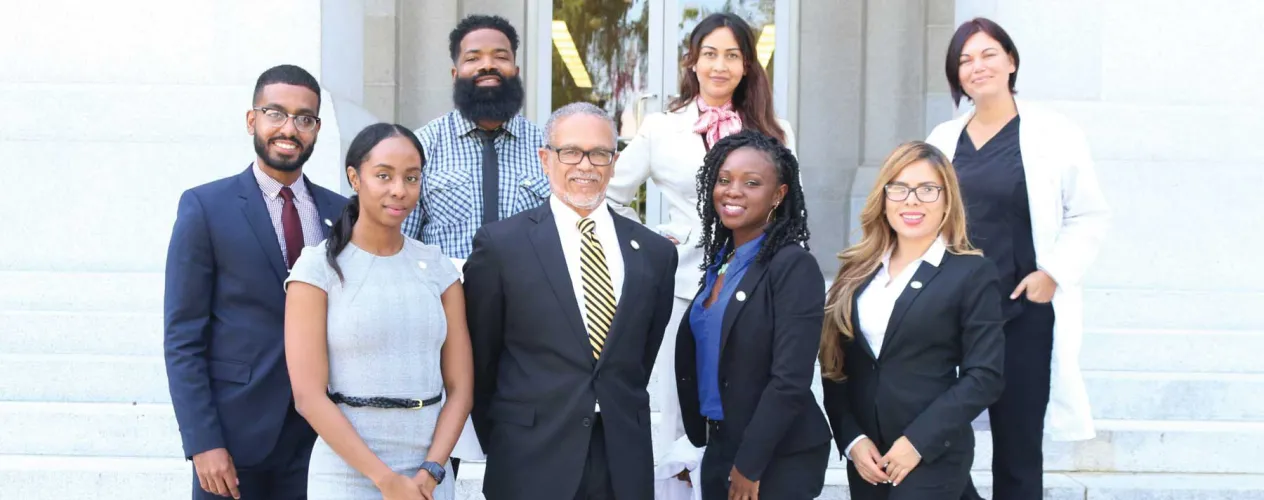Caring for All Communities
Dr. David Carlisle, a leader in bringing diversity to the health care professions, applies the lessons of his FSPH education.

WHEN DR. DAVID CARLISLE (MPH ’88, PHD ’92) looks out the window of his office at Charles R. Drew University of Medicine and Science (CDU), where he serves as president and CEO, he is reminded of the urgency of CDU’s work in bringing more diversity into the health care professions.
“I can see the 105 Freeway that divides Willowbrook from Watts in South Los Angeles, and you can’t find private practicing health professionals — doctors, dentists, psychologists, pharmacists, optometrists... — anywhere in this community,” Carlisle says. “The main sources of providers are federally qualified health centers, which are doing a great job, but that can’t be the only solution. We can’t improve our health care system if we don’t improve it in communities like South Los Angeles, where there is a crying need.”
Carlisle has dedicated his career to advancing the health of under-resourced communities, a passion he traces to his own early experience with health care. He vividly recalls a childhood visit to a primary care clinic in northern Virginia, where the waiting room was packed with low-income African American patients with no other alternative but to spend hours awaiting their turn. “I thought that was normative until I started living in more affluent environments, where seeing the doctor didn’t involve crowded waiting rooms,” Carlisle says. “That’s when it occurred to me that health care wasn’t the same across different communities, and that it seemed to be correlated with both socioeconomic status and ethnicity.”
Our most under-resourced populations are not able to participate fully in the best aspects of American health care.
A critical component to addressing these disparities involves diversifying the health care workforce. Carlisle notes that health care providers from under-resourced communities are most likely to return to those communities to practice, and that a diverse health care workforce affects not only access, but also quality of care. “Concordance between patients and their providers is a critical factor in addressing health disparities,” Carlisle says. “We hear it from patients and we see it in the research.”
Since 2011, Carlisle has led an institution that few can match when it comes to increasing the level of diversity in health care. CDU is a private, community-founded institution where more than 80% of the students and more than 71% of the faculty are from communities of color. In the five decades since the institution was incorporated in 1966, CDU has graduated more than 600 physicians, more than 1,200 physician assistants, and nearly 1,600 other health professionals, and trained more than 2,700 physician specialists through its sponsored residency programs. CDU’s nursing school has graduated more than 1,300 nursing professionals, including nearly 1,000 family nurse practitioners. More than 80% of CDU students report returning to practice and providing much-needed care in under-resourced communities after graduation. “This is a university that’s been delivering on its formative mission for our entire 53-year history, and we’re being recognized for it,” Carlisle says.
Carlisle began addressing the issues of health disparities and health care workforce diversity long before he got to CDU. He spent 11 years as director of California’s Office of Statewide Health Planning and Development (OSHPD) in the administrations of three governors — Gray Davis, Arnold Schwarzenegger, and Jerry Brown. Under Carlisle’s leadership, OSHPD released its first-ever health disparities report, helped to draft a policy to develop a health workforce data clearinghouse, and increased scholarship and loan repayment opportunities for health providers committed to practicing in underrepresented, under-resourced, and underserved communities. Carlisle has also long devoted his medical practice to caring for people with the greatest need. For nearly three decades he served as a volunteer physician at the Venice Family Clinic, a nonprofit community health center, and currently serves on its foundation board.
Carlisle was a staff physician overseeing the urgent care clinic at the Watts Health Center in the mid-1980s when he began taking courses in the Fielding School’s Health Policy and Management Executive MPH program. The experience proved pivotal. “It totally changed my career orientation,” Carlisle says. “I was exposed to an entirely different perspective on health and health care — the population-based approach of taking care of the needs of thousands of people at a time instead of one patient at a time. I learned about managed care, health care economics, and what public health really meant. I felt like a kid in the candy shop — I just wanted to delve deeper and deeper into the subject area, which I found to be compelling and captivating.”
Over the ensuing years, culminating with the completion of his PhD in 1992, Carlisle engaged in a constant dialogue with FSPH faculty mentors about the need for universal health insurance. Through those interactions, he began to question why individuals from under-resourced communities couldn’t have access to the same quality of health care as those from more affluent communities.
“When you look at health outcomes in the United States, we lag behind other industrialized nations on most measures, and I would argue that the reason is that our most under-resourced populations are not able to participate fully in the best aspects of American health care,” Carlisle says. “The result is the divergent quality of care, satisfaction with care, and health outcomes among those in under-resourced communities, many of which are communities of color. Effectively addressing the needs of these communities would go a long way toward bridging the health care gap between the United States and the rest of the industrialized world.”